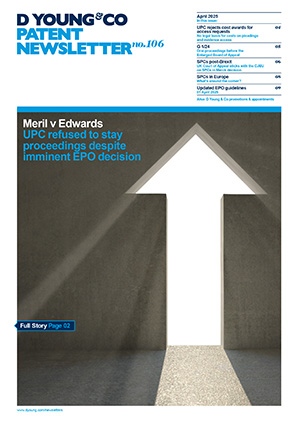Interpreting patent claims: G 1/24 seeks Enlarged Board of Appeal clarification
G 1/24 seeks clarification of the legal basis for interpreting patent claims for the purpose of assessing patentability, particularly whether and to what extent the description and figures may be used. Recent Unified Patent Court (UPC) decisions have suggested that the description and drawings must always be used, highlighting a potential divergence in approach between the EPO and UPC. This referral has arisen from T 0439/22, an appeal from the decision of the EPO’s Opposition Division to maintain Philip Morris Products SA’s patent EP 3076804 B1 as granted.
The patent relates to a heated aerosol-generating article comprising an aerosol-forming substrate comprising a “gathered sheet” of aerosol-forming material. The Board of Appeal considered that the definition of the term “gathered” provided in the description of the patent was broader than that normally used in the technical field, because it additionally included materials that were “convoluted, folded, or otherwise compressed or constricted”.
The prior art cited for novelty discloses subject matter that would anticipate the claims based on the broader definition of “gathered” provided by the description, but not on the narrower definition, which is commonly used in the technical field.
Thus, the determination of this point of novelty depends on whether the definition provided in the description of the patent should prevail.
In its interlocutory decision, the Board of Appeal discussed divergence in the legal basis for construing claims and considered that it could not determine whether the claims were valid. In particular, the Board of Appeal considered there to be divergence on the following points:
- whether a patent claim must be shown to be unclear or ambiguous on its face before the figures and description can be taken into account to construe that claim; and
- the extent to which a patent can serve as its own dictionary.
The Board of Appeal has referred the following questions to the Enlarged Board of Appeal:
- Is Article 69(1), second sentence EPC and Article 1 of the Protocol on the Interpretation of Article 69 EPC to be applied to the interpretation of patent claims when assessing the patentability of the invention under Articles 52 to 57 EPC? [see Reasons, points 3.2, 4.2 and 6.1]
- May the description and figures be consulted when interpreting the claims to assess patentability, and, if so, may this be done generally or only if the person skilled in the art finds a claim to be unclear or ambiguous when read in isolation? [see Reasons, points 3.3, 4.3 and 6.2]
- May a definition or similar information on a term used in the claims which is explicitly given in the description be disregarded when interpreting the claims to assess patentability and, if so, under what conditions? [see Reasons, points 3.4, 4.4 and 6.3]
Two possible approaches to claim interpretation may be: (a) for the wording of the claims to be considered alone in the first instance, with the description and drawings being consulted only for clarification (see for example decision T 0169/20); or (b) for the invention to be considered in the context provided by the description and drawings in the first instance (see for example T 1473/19).
The Board of Appeal also cited passages from the UPC Court of Appeal’s decision in UPC CFI 2/2023 (see Reasons, point 4.3.4): “The interpretation of a patent claim does not depend solely on the strict, literal meaning of the wording used. Rather, the description and drawings must always be used as explanatory aids for the interpretation of the patent claim and not only to resolve any ambiguities in the patent claim.”
The UPC Court of Appeal further stated that: “these principles for the interpretation of a patent claim apply equally to the assessment of the infringement and the validity of a European patent”.
The Enlarged Board of Appeal must first decide whether the referral is admissible, specifically whether the Board of Appeal’s contention is correct that a decision is required to ensure uniform application of the law, and/or that a point of law of fundamental importance has arisen.
If the referral is deemed admissible, it will be interesting to see how the Enlarged Board of Appeal answers the questions: depending on the outcome of this referral to the Enlarged Board of Appeal, the UPC and EPO could arrive at different conclusions regarding patent validity.
The EPO has also already stated that, despite this referral, examination and opposition proceedings will continue as normal, and will thus not be stayed until the decision is issued.
Useful links
- EPO Referral on claim interpretation (G 1/24), 02 July 2024: dycip.com/referral-claim-g1-24
- T 0439/22 (gathered sheet), 24 June 2024: dycip.com/gathered-sheet-t-0439-22
- T 0169/20 (pouch with inner container/Reckitt), 23 January 2023: dycip.com/epo-t-016920
- T 1473/19, 30 September 2022: dycip.com/epo-t-1473-19
- UPC_CFI_2/2023, 19 September 2023: dycip.com/upc-nanostring-10x-cfi

